Chapter 7 - Cellular Respiration
Chapter 7 Cellular Respiration
Slide 2: General Formulas

Respiration:
C6H12O6 + 6O2 -> 6CO2 + 6H2O + energy
Photosynthesis:
6CO2 + 6H2O -> C6H12O6 + 6O2
Slide 3: Locations of Cellular Respiration
Glycolysis: Occurs in the cytoplasm.
Krebs Cycle: Takes place in the matrix of mitochondria.
Electron Transport Chain (ETC) & ATPase: Located in the cristae of mitochondria.
Cristae is the folded inner membrane
Slides 4: Types of Respiration
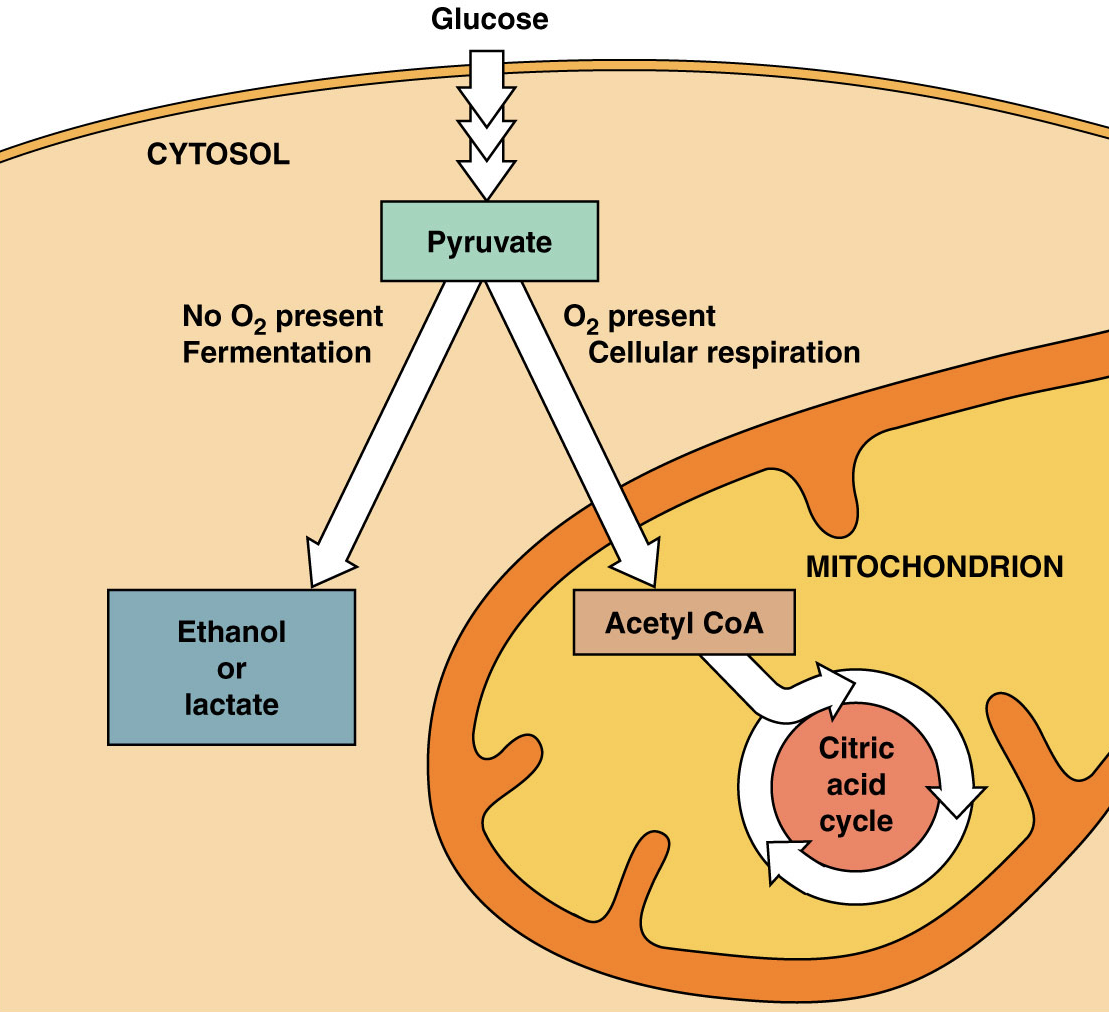
Anaerobic Respiration:
Has no O2 present; involves glycolysis in the cytoplasm as the first step and fermentation reactions in the 2nd step
Aerobic Respiration:
Requires O2; includes glycolysis in the cytoplasm as the first step, imports into the mitochondria in the 2nd step, Krebs cycle in the 3rd, and electron transport (cristae) in the 4th.
Slide 5-7: Stages of Aerobic Respiration
The purpose of aerobic respiration is to breakdown sugars and other food molecules to make ATP
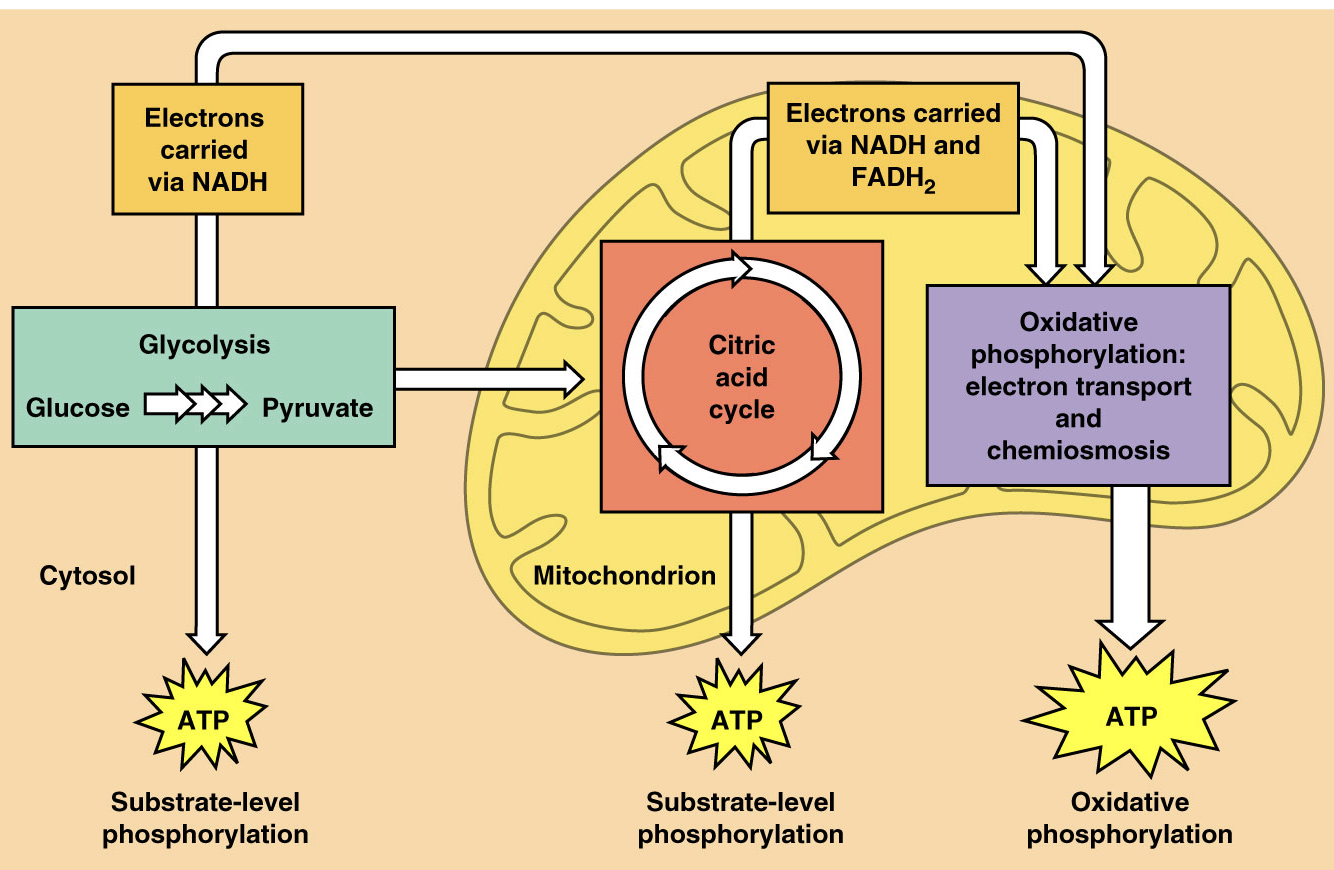
Glycolysis - In cytoplasm
Import into Mitochondria (Transition Step)
Krebs Cycle (Citric Acid Cycle) - In the Matrix
Electron Transport Chain and ATP Synthesis
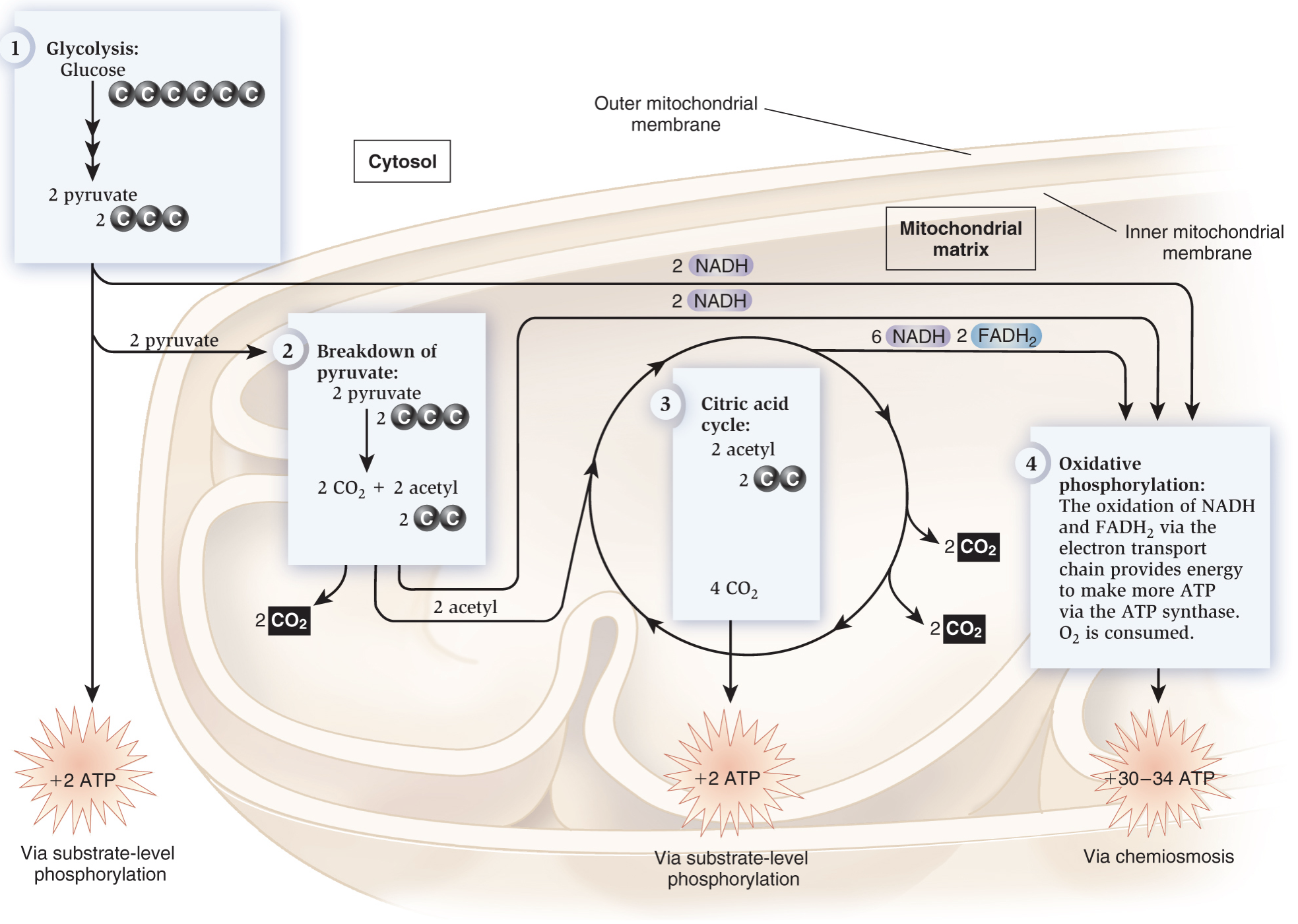
Slide 6: Electron Carrier
Electrons are carried by NADH and FADH2.
Phosphorylation Types:
Substrate-level phosphorylation
Oxidative phosphorylation
Slide 7: Glycolysis Breakdown
Glycolysis:
Converts glucose into pyruvate, producing NADH and ATP.
Krebs Cycle:
Produces CO2, ATP, NADH, and FADH2.
Page 8: Glycolysis Phases
Energy Investment Phase:
2 ATP used to convert glucose into fructose-1,6-bisphosphate.
Energy Payoff Phase:
Produces 4 ATP and 2 NADH.
Slide 9: Parts of Glycolysis
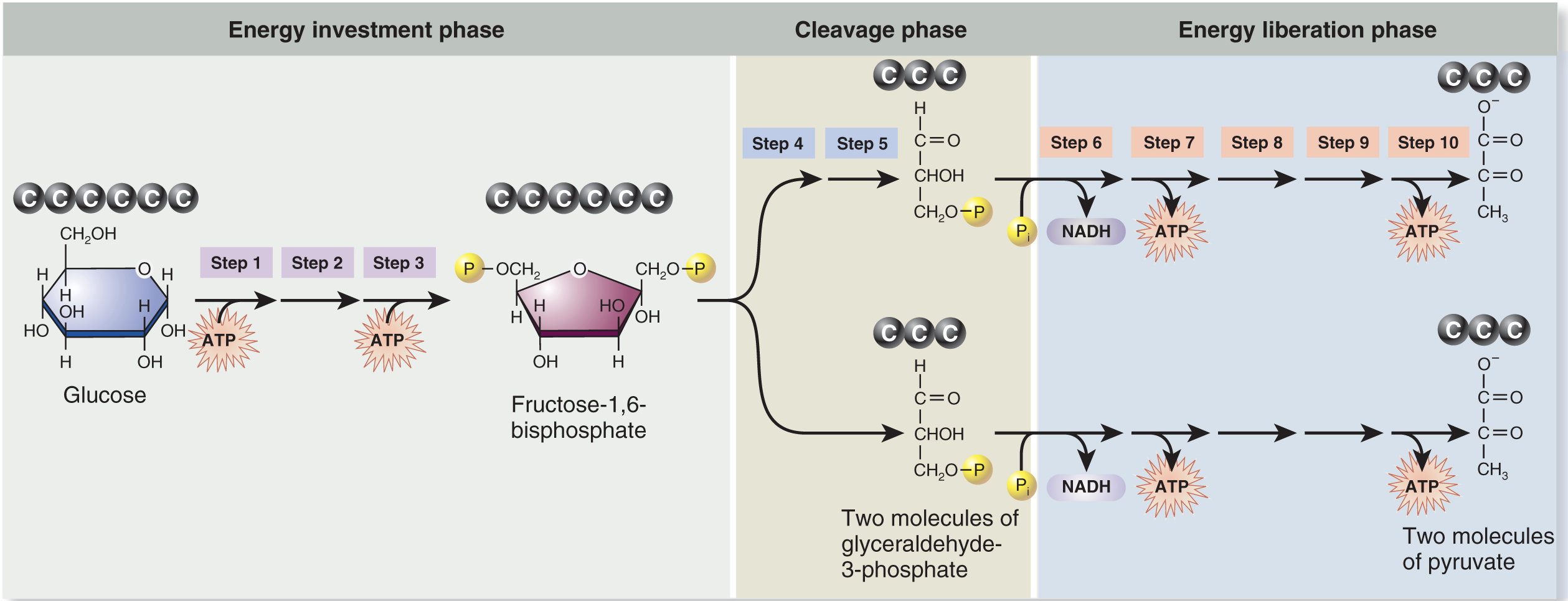
Part 1: Energy Investment Phase (steps 1-3); Cleavage and rearrangement (steps 4-5)
Part 2: Energy Payoff Phase (steps 6-10)
Slide 10: Glycolysis Details
Energy Investment:
Glucose (C6) + 2 ATP -> Fructose-1,6-bisphosphate (C6) + 2 ADP
Cleavage & Rearrangement:
Fructose-1,6-bisphosphate (C6) -> 2 G3P (C3)
G3P: Glyceraldehyde-3-phosphate
Slide 11: Glycolysis Part 1
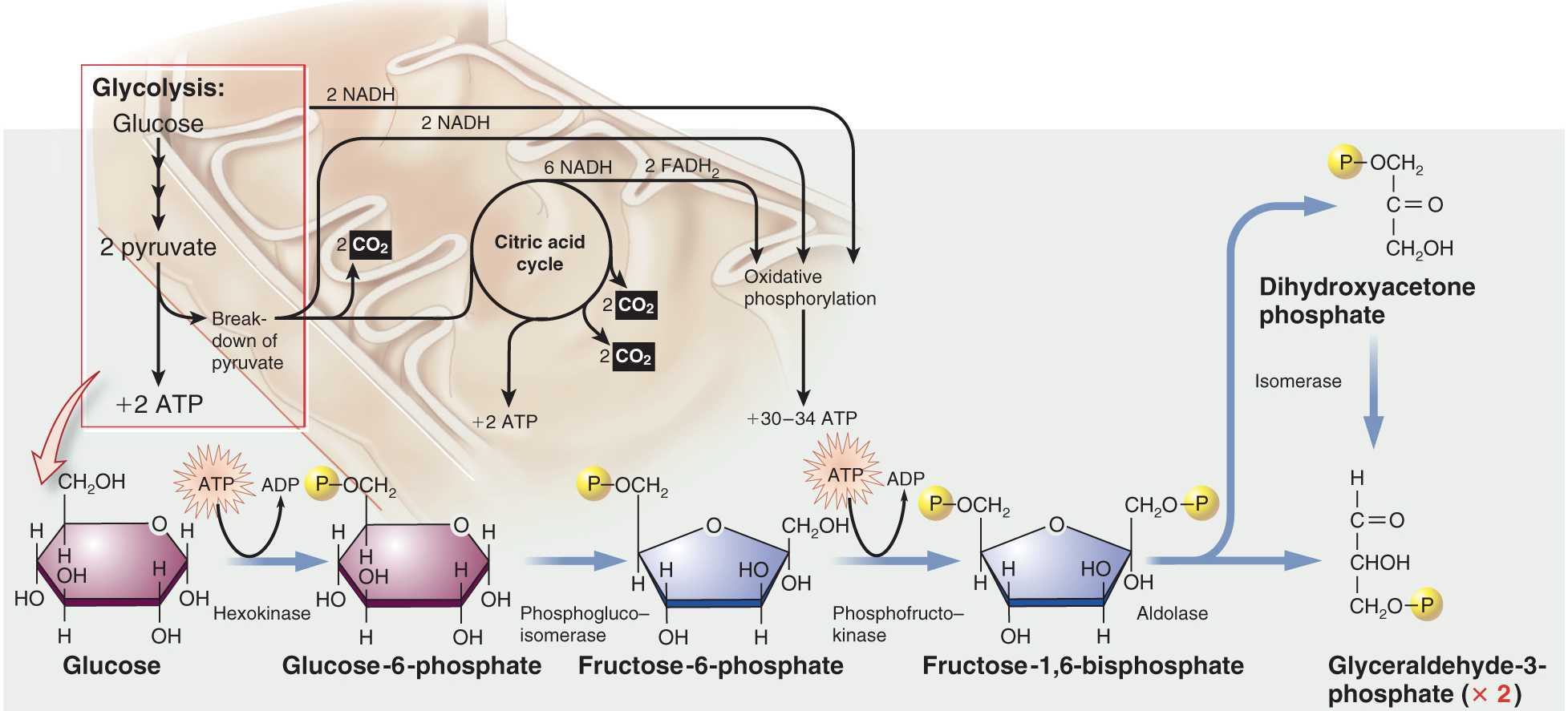
Glucose C6 → DHAP C3 + G3C3 → 2 G3P C3
Energy input: 2 ATP
Start with C6 sugar
DHAP = Dihydroxyacetone
G3P = glyceraldehyde 3
Both sugars
Slide 12: Glycolysis Part 2

Glyceraldehyde-3 phosphate (2x); After split in half 2x C3 sugars
(G3P C3 → → → Pyruvate C3) x2
Part 2 energy output: 4 ATP + 2 NADH
Slide 13: Glycolysis Summary Part 1
Substrate: Glucose (C6 sugar)
Product (end of step 4): 2 C3 sugars (1 DHAP + 1 G3P)
Slide 14: Glycolysis Summary Part 2
Substrate: 2 G3P (C3)
Product: 2 pyruvate (C3 sugars)
Slide 15: Glycolysis Energy Yield
Part 1 Energy Input: 2 ATP
Part 2 Energy Output: 2 NADH + 4 ATP
Net Energy Yield: 2 ATP + 2 NADH
Page 16: Glycolysis Overview
Part 1: Energy In: 2 ATP
Part 2: Energy Out: 4 ATP + 2 NADH
Net Yield: 2 ATP + 2 NADH
Slide 19-21: Import into Mitochondria (Transition step)

Pyruvate C3 + NAD+ + CoA -> Acetyl CoA + CO2 + NADH
Net Energy Yield/Glucose: 2 NADH
Coenzyme A
Acetyle CoA = acetyl (from pyruvate) attached to coenzyme A
Slide 22: Krebs Cycle Overview
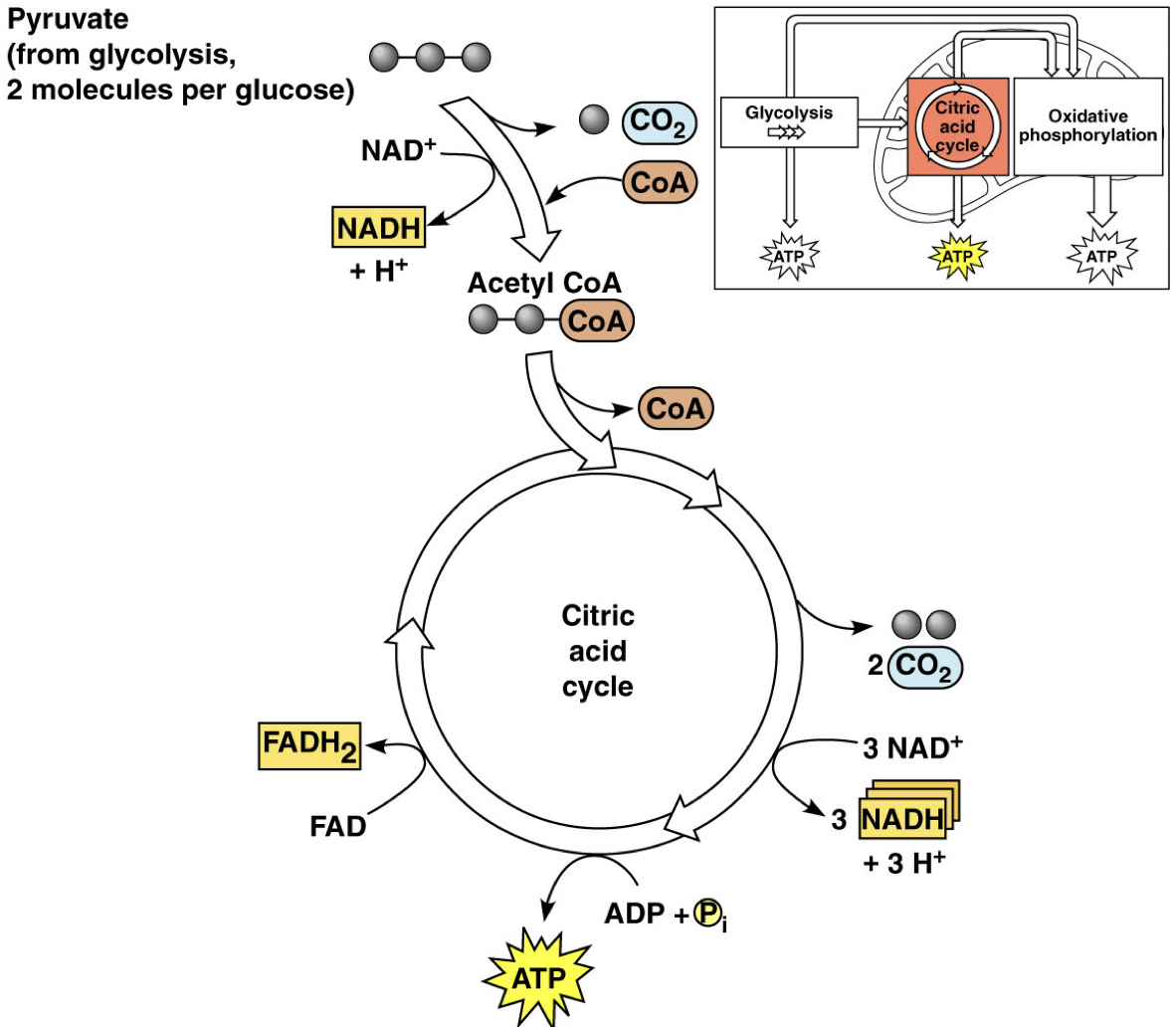
Input: 2 Acetyl CoA C2 + 2 Oxaloacetate C4 -> 2 Citric Acid C6+ 2 CoA
Slide 23: Krebs Cycle Reactions
(1st reaction) Acetyl CoA C2 + Oxaloacetate C4 -> Citric Acid C6 +CoA
Sugars are rearranged, decarboxylation → CO2 is relased
Sugars are oxidized → Redox
Reduced, High energy compounds made NADH, FADH2
Slide 27: Energy Yield of Krebs Cycle
Energy Per Cycle: 1 ATP, 1 FADH2, 3 NADH
Energy Per Glucose: 2 ATP, 2 FADH2, 6 NADH
Slide 29: Net Energy Yield of Aerobic Respiration
Total: 4 ATP + 10 NADH + 2 FADH2
All of the ATP made so far was made by substrate-level phosphorylation
Slide 31: Electron Transport Chain (ETC)
Purpose: Uses energy from NADH and FADH2 to produce ATP by oxidative phosphorylayion = chemiosmosis
Electron Transport: makes a H+ gradient
oxidative phosphorylation: Creates a H+ gradient for ATP synthesis.
Slide 34: Electrons carriers are Arranged by Redox Potential in Cristae
Electrons are passed down energy gradient in small increments
H+s are pumped across membrane
Slide: 38 Types of Electron Carries in the Electron Transport Chain
Protein complexes in Cristae Membrane
Complex 1
Complex 2
Complex 3
Complex 4: Cytochrome c oxidase
Mobile Electron Carries
Coenzyme Q/ Ubiquinone
Quinon = lipid
Cytochrome c = Small protein
Slide: 40:Electron Transport Generates a Proton Gradient
As e-s are transported down the ETC, H+s are transported across the cristae membrane into the inter membrane space at 3 places:
Complex 1, complex 3 and complex 4
The H+ gradient will be used as energy for ATP synthesis
Slide 41: ATP Synthesis
ETC: Makes a H+ gradient = proton gradient
ATP Synthase: Uses H+ gradient as a source of energy to make ATP
Slide 43: Pathway of Electron Transport
When NADH donates e-s to the ETC the order of electron carries is:
NADH → 1 → CoQ → 3 → Cyto → 4 → O2
When FADH2 donates e-s to the ETC the order of electron carries is:
FADH2 → 2 → CoQ → 3 → cyto → 4 → O2
ETC: Electron transport chain
1 FADH2/ 2ATP
Page 46: Consequences of Stopping Electron Transport
Lack of O2 leads to no H+ gradient, halting ATP synthesis.
Slide 48: Poisons Stop Aerobic Respiration
Many posions stop e- transport → no ATP synthesis Arsenic stops Krebs Cycle, inhibits part of Glycolysis
Slide 49: What happens if Electron Transport stops
No H+ gradient is made → no energy to make ATP! ATP synthesis will stop
Electron carries cant pass on their electrons, will all be stuck in reduced form
Slide 50: Krebs Cycle
If no O2 all NAD+ will be in NADH form
Cell will run out of NAD+/FAD+
Any reactions that needs NAD+ or FAD+ will stop
Slide 51: Glycolysis Part 2
If no O2 all NAD+ will be in NADH form
Any reaction that uses AND+ will stop Aerobic Respiration will stop
Glycolysis will also stop unless there is another set of reactions to make NAD+ (Fermentation)
Slide 52: Electron Transport chain and Oxidative Phosphorylation
Purpose: uses the energy in NADH and FADH2 To make ATP by Oxidative Phosphorylation = Chemiosmosis
Electron Transport: makes a H+ gradient
Oxidative Phosphorylation: uses the H+ gradient to make ATP
ATP synthase
Slide 53: Electron Transport and ATP Synthesis
ETC: Makes a H+ gradient = proton gradient
ATP Synthase: Uses H+ gradient as a source of energy to make ATP
Slide 57 : Energy Conversions
Electrons from NADH
Pass through 3 proton pumping steps → A larger H+ Gradient is made → 3 ATP/NADH
Electrons from FADH2:
Only pass through 2 proton pumping steps → Smaller gradient made → only 2 ATP / FADH2
Aerobic Respiration: Net Energy Yield per Glucose
Glycolysis: 2 ATP +(2*3=6ATP)
Import into Mt.: +(2*3=6ATP)
Krebs Cycle: 2 ATP +(6*3=18ATP)+ (2*2=4ATP)
Total= 4 ATP +30 ATP* +4 ATP* = 38 ATP
4 ATP by Substrate-level Phosphorylation = ( Enzyme reaction)
34 ATP by Oxidative Phosphorylation
No free shipping! moving 2 NADH into mitochondria costs 1 ATP/NADH
2 NADH made in cytoplasm move into mitochondria
Net gain in ATP: 38 ATP max - 2 ATP shipping = 36 ATP
Slide 62: Anaerobic Respiration Overview
Process: Glycolysis followed by fermentation.
Net Energy Gain: 2 ATP.
Slide 64: Alchohol Fermentation
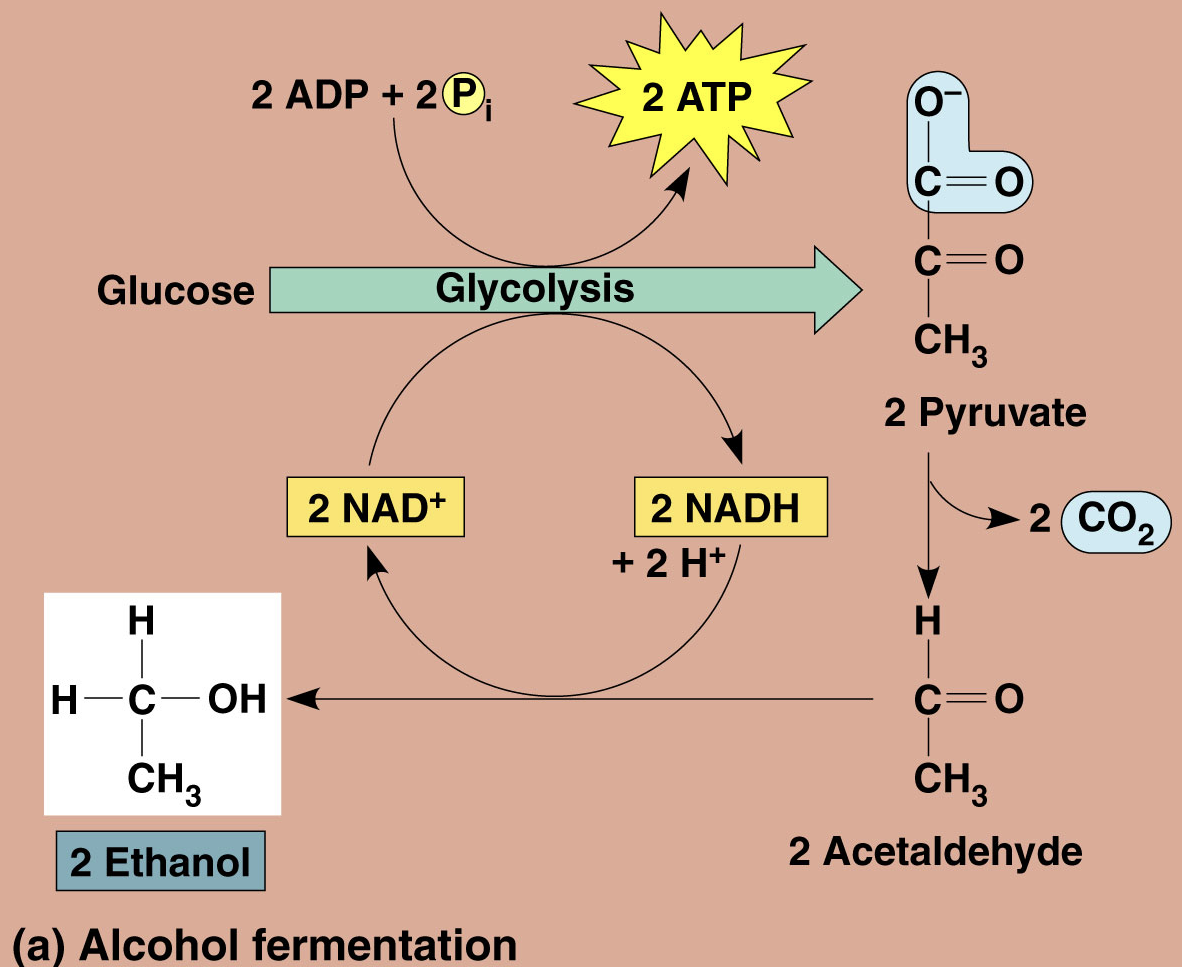
In plants fungi and some bacteria
Uses up 2 NADH! No ATP or O2 made!
Slide 65: Lactic Acid Fermentation
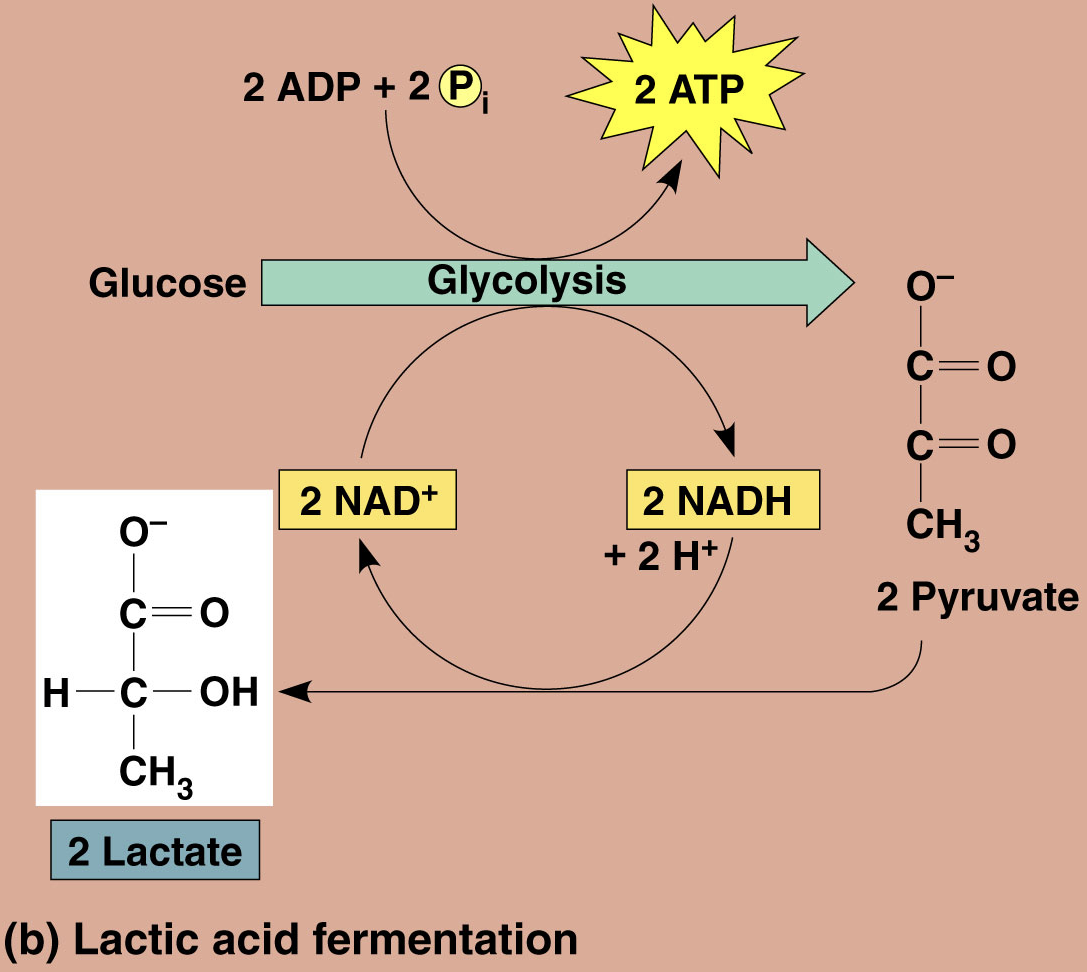
In animals and some bacteria
Slide 66: Purpose of Fermentation
Recycles NAD+ to allow glycolysis to continue.
Even if there is no energy gain cells carry out the fermentation reactions to regenerate the NAD+ so glycolysis can keep going
Slide 68: Anaerobic Respiration
Glycolysis: Makes 2 ATP + 2 NADH
Fermentation: 2 NADH → 2 NAD+
Recycles NAD+ so glycolysis can continue
Even if there is no energy gain the cells carry out the fermentation reactions to regenerate the NAD+ so glycolysis can continue
Slide 70: Products of Fermentation
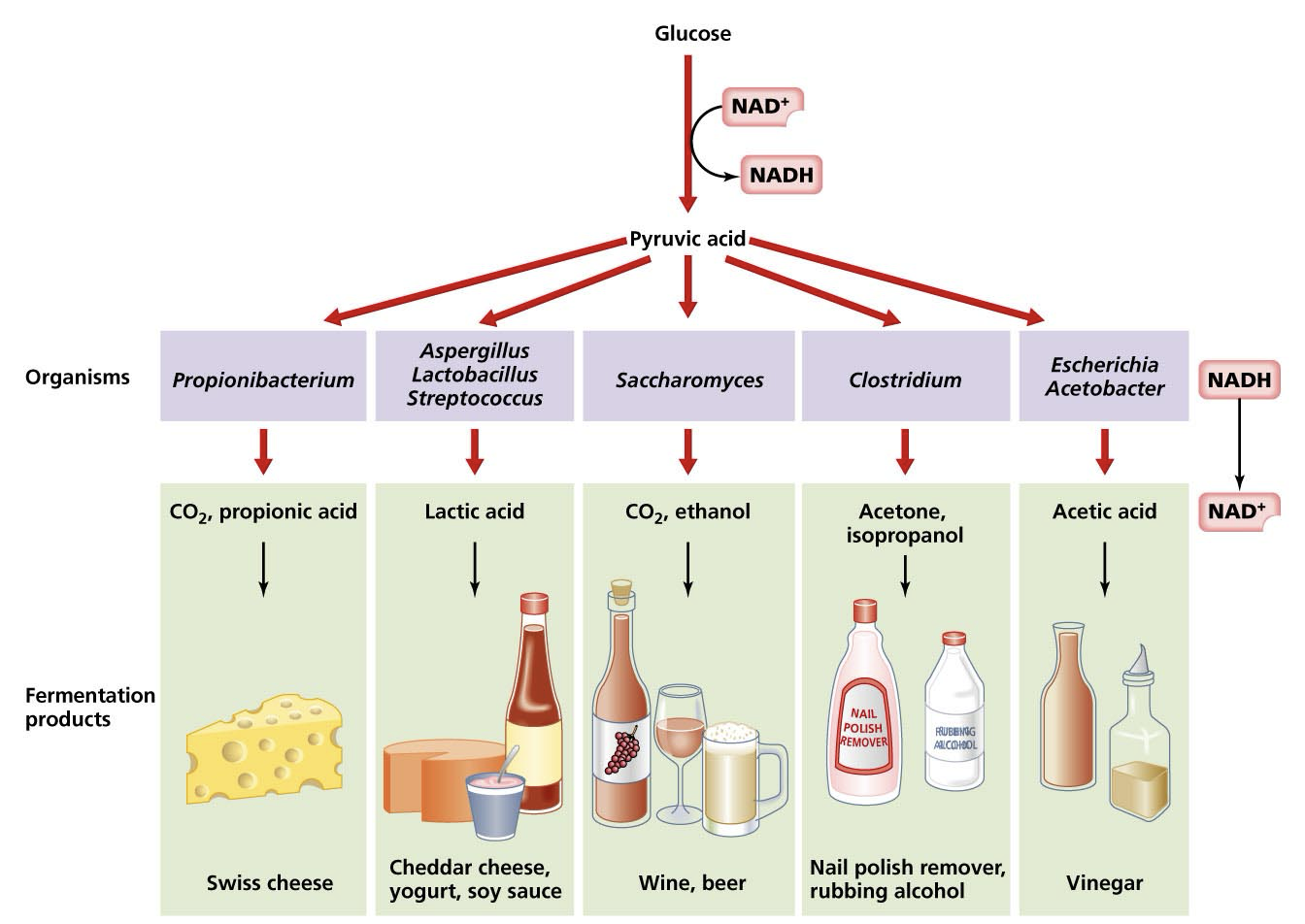
Lactic Acid Fermentation: Produces lactate.
Alcohol Fermentation: Produces ethanol and CO2.
Slide 71: Metabolism of Food Molecules
Carbohydrates: Starch, disaccharides, sugars.
Fats = Triglycerides:, glycerol, fatty acids.
Proteins: Amino acids.
Slide 72: Food Digestion
Carbohydrates starch → glucose C6 sugars → Enter at the beginning of glycolysis (Part 1 = C6 sugars)
Disaccharides → C6 Sugars → Enter at beginning of Glycolysis (Part 1 = C6 sugars)
Fats = Triglycerides → Glycerol C3 + 3Fatty Acids
Glycerol C3 → G3P C3 Enter at the middle of glycolysis (Part 2 = C3 sugars)
Fatty Acids C18 → Acetyl CoA C2 ×9 by beta oxidation Enter at 1st step of citric acid cycle (Krebs cycle)
Slide 76: Protein Metabolism
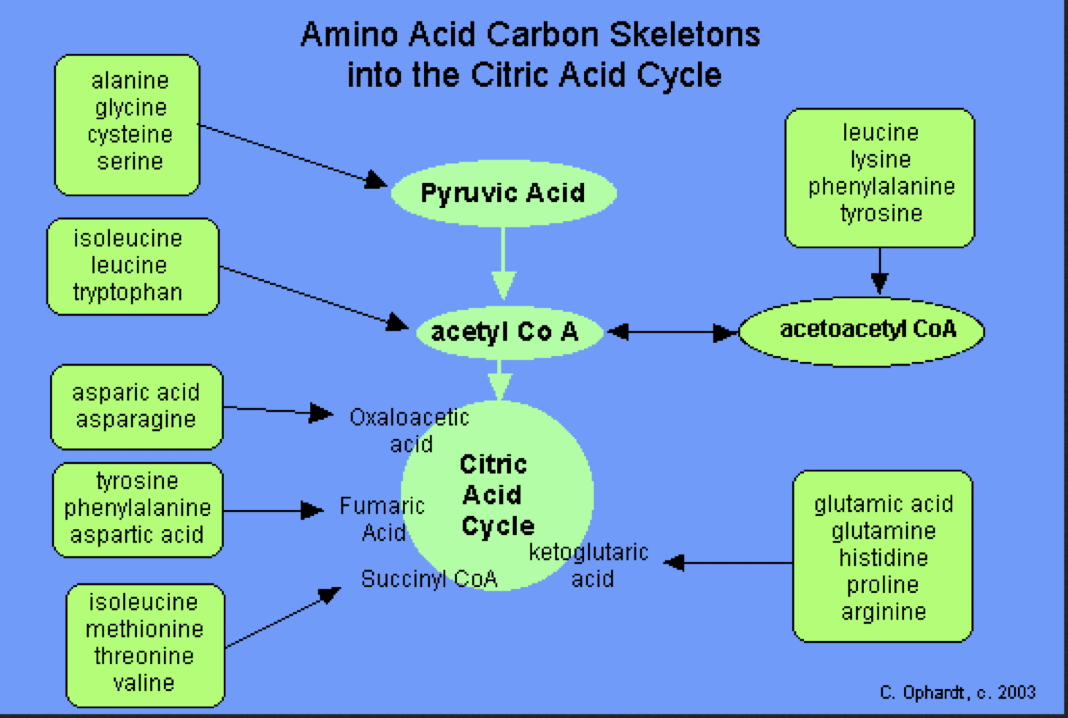
Amino Acid C skeletons converted to sugars that can be broken down during Respiration
Slide 77-78: Key Reactions to Memorize
Import into Mitochondria (Transition Step): Pyruvate (C3) + CoA + NAD+ -> Acetyl CoA (C2) + CO2 + NADH
Krebs Cycle = Krebs Cycle: Acetyl CoA(C2) + Oxaloacetate(C4) -> Citric Acid (C6)+ CoA
Fermentation: Animals
Pyruvate(C3) + NADH → LACTIC ACID (C3) + NAD+
Fermentation: Plants, Fungi
Pyruvate (C3) → Acetaldehyde (C2) + CO2 Acetaldehyde (C2) + NADH → Ethanol (C2) + NAD+